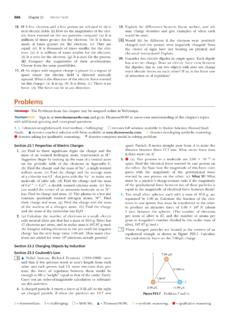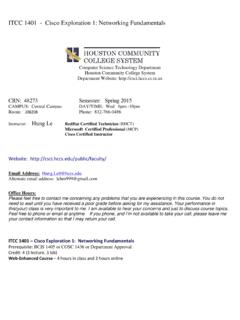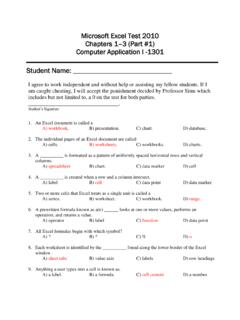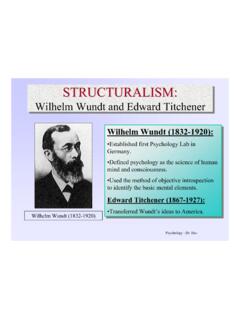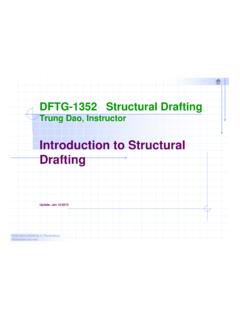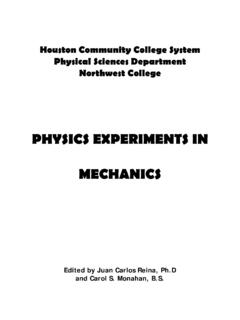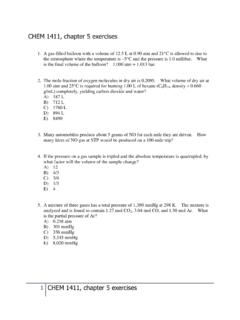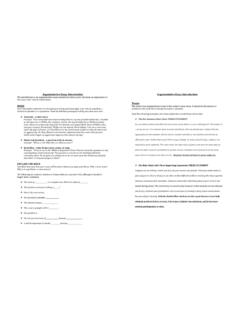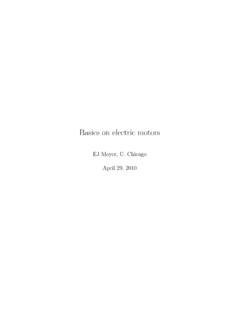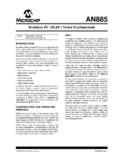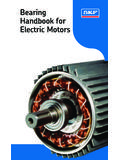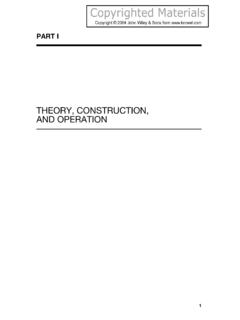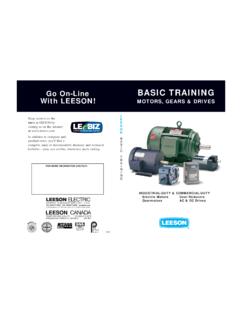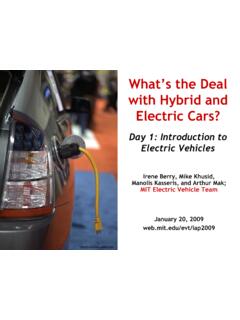Transcription of SECTION 4 ELECTRIC MOTORS UNIT 17: TYPES OF ELECTRIC …
1 SECTION 4. ELECTRIC MOTORS . UNIT 17: TYPES OF ELECTRIC . MOTORS . UNIT OBJECTIVES. After studying this unit, the reader should be able to Describe the different TYPES of open single-phase MOTORS used to drive fans, compressors, and pumps. Describe the applications of the various TYPES of MOTORS . State which MOTORS have high starting torque. List the components that cause a motor to have a higher starting torque. Describe a multispeed permanent split-capacitor motor and indicate how the different speeds are obtained. UNIT OBJECTIVES. After studying this unit, the reader should be able to Explain the operation of a three-phase motor . Describe a motor used for a hermetic compressor. Explain the motor terminal connections in various compressors. Describe the different TYPES of compressors that use hermetic MOTORS . Describe the use of variable-speed MOTORS . USES OF ELECTRIC .
2 MOTORS . Used to turn fans, pumps and compressors Facilitate the circulation of air, water, refrigerant and other fluids MOTORS are designed for particular applications The correct motor must always be used Most MOTORS operate on similar principles Fans are used to move air Pumps are used to move liquids PARTS OF AN ELECTRIC motor . Stator with motor windings Stationary portion of the motor Rotor Rotating portion of the motor Bearings Allow free rotation of the motor shaft End bells Supports the bearings and/or shaft Housing Holds all motor components together and facilitates motor mounting Housing and Stator Electrical Connections Rotor End Bell Mounting Base Shaft Parts of an ELECTRIC motor ELECTRIC MOTORS AND. MAGNETISM. Electricity and magnetism are used to create rotation Stator has insulated windings called run windings Rotor may be constructed of bars Squirrel cage rotor Positioned between the run windings Rotor turns within the magnetic field Magnet supported from above N.
3 Since unlike poles repel N. each other, the magnet will rotate S. S. Stationary Magnet N. S. Stationary Magnet N. S. Stationary Magnet N. S. N. S. Stationary Magnet N. S. Stationary Magnet N. S. Stationary Magnet N When the unlike poles are lined up with each other, S rotation will stop N. S. Stationary Magnet DETERMINING motor SPEED. As the number of poles increases, the motor speed decreases motor Speed (rpm) = Frequency x 120 # of poles In the United States the frequency is 60 Hz For example, a 2 pole motor will turn at a speed of 60 x 120 2 = 7200 2. = 3600 rpm The motor will turn at a speed that is lower than the calculated value Slip = difference between calculated and actual motor speed THE START WINDING. Enables the motor to start and in the right direction Start winding has higher resistance than the run winding Wound with more turns than the run winding Wound with smaller diameter wire than the run winding Removed from the active circuit once the motor starts STARTING AND RUNNING.
4 CHARACTERISTICS. Refrigeration compressors have high starting torque Starting torque twisting force that starts the motor Locked Rotor Amperage (LRA). Full Load Amperage (FLA). Rated Load Amperage (RLA). motor may start with unequal pressures across it Small fans do not require much starting torque ELECTRICAL POWER. SUPPLIES. Residences are furnished with single-phase power Houses can be supplied power from the transformer Power feeds into circuit breaker panel or fuse box Circuit breakers protect each individual circuit Power is distributed throughout the house Typical residential panels provide 115 and 230 volts Commercial and industrial facilities require three-phase power L1 L2. Individual 115-volt circuits with 115-volt, Main Circuit Breakers single-phase circuit breakers 230-volt two-pole circuit breakers and 230-volt circuits Neutral and Ground Bus RESIDENTIAL CIRCUIT BREAKER PANEL.
5 SINGLE-PHASE OPEN. MOTORS . Residential MOTORS operate at 115, 208 or 230V. Commercial MOTORS operate at voltages up to 460V. Some MOTORS are designed to operate at one of two different voltage (dual voltage MOTORS ). Dual voltage MOTORS are wired differently for each voltage Some MOTORS have reversible rotations DUAL VOLTAGE motor (230-VOLTS). Start Winding Starting Switch Run Windings 230-volt power supply Run windings are wired in series with each other for high- voltage application DUAL VOLTAGE motor (115-VOLTS). Start Winding Starting Switch Run Windings 115-volt power supply Run windings are wired in parallel with each other for low-voltage applications SPLIT-PHASE MOTORS . Two separate motor windings Good running efficiency Medium amount of starting torque Speed typically ranges from 1800 3600 rpm motor speed is determined by the number of poles Slip is the difference between the calculated and actual motor speeds START WINDING.
6 Small Wire Large Number of Turns High Resistance L1. RUN WINDING. Larger Wire L2. Small Number of Turns Low Resistance 120 Volts RUN. Rotor START. START. RUN. THE CENTRIFUGAL SWITCH. Commonly used on open MOTORS to de-energize the start winding Opens its contacts when the motor reaches about 75% of its rated speed When the contacts open and close, a spark is created (arcing). Not used in a refrigerant atmosphere START WINDING THE CENTRIFUGAL SWITCH. Small Wire Large Number of Turns High Resistance L1. RUN WINDING. Larger Wire L2. Small Number of Turns Low Resistance CAPACITOR-START motor . Split phase motor with start and run windings Start capacitor assists the motor starting by increasing the starting torque Start capacitor is wired in series with the motor 's start winding Start capacitor is removed from the circuit when the start winding is removed Start capacitor increases the phase angle CAPACITOR-START motor .
7 START. CAPACITOR. START. L1. RUN. L2. PHASE ANGLE. Number of electrical degrees between the current and the voltage In a resistive circuit the current and voltage are in phase with each other and the phase angle is zero The current can lead or lag the voltage In inductive circuits, the current lags the voltage In capacitive circuits, the current leads the voltage CAPACITOR-START, CAPACITOR-RUN motor . Most efficient single-phase motor Often used with belt-driven fans and blowers Run capacitor improves running efficiency Run capacitor is in the circuit whenever the motor is energized Start and run capacitors are wired in parallel motor amperage will rise if run capacitor goes bad CAPACITOR-START, CAPACITOR-RUN motor (CSCR). RUN CAPACITOR. START. CAPACITOR. L1. L2. PERMANENT SPLIT. CAPACITOR (PSC) motor . Simplest split-phase motor Only a run capacitor is used Low starting torque and good running efficiency Can be single or multispeed MOTORS Multispeed MOTORS have leads for each speed As the resistance decreases, motor speed increases As the resistance increases, motor speed decreases PERMANENT SPLIT CAPACITOR motor (PSC).
8 RUN CAPACITOR. L1. L2. SHADED-POLE motor . Very low starting torque Not as efficient as the PSC motor A portion of the run winding is shaded to provide the imbalance in magnetic field that allows the motor to start Heavy copper wire or bands are used to shade the run winding Manufactured in the fractional horsepower range THE SHADED POLE motor . BANDS OF HEAVY COPPER. COIL. LAMINATED CORE ROTOR. THREE-PHASE motor . Normally used on commercial applications Must have a three-phase power supply Powered by three single-phase power supply legs Has no start winding or capacitors Very high starting torque Rotation of motor can be changes by switching any two power legs THREE-PHASE 220-VOLT POWER SUPPLY. L1 L2 L3. THESE THREE POWER SUPPLIES ARE. GENERATED 120 DEGREES OUT OF PHASE. WITH EACH OTHER. SINGLE-PHASE HERMETIC. MOTORS . Hermetically sealed from outside air Similar to single-phase MOTORS Use relays to remove start winding from circuit They do not use centrifugal switches Often use run capacitors for increased efficiency Designed to operate in a refrigerant atmosphere motor terminals identified as common, start & run THE POTENTIAL RELAY.
9 Used on MOTORS requiring high starting torque Coil with very high resistance Normally closed contacts Relay operates on the induced voltage across the start winding The contacts open when the induced voltage rises When the motor turns off, the induced voltage drops and the relay contacts close THE POTENTIAL. RELAY. 2. 5. Normally close contacts 1 connected between terminals 1. and 2. Coil connected between terminals 2 and 5. CAPACITOR-START, CAPACITOR-RUN motor (CSCR). 5. START. CAPACITOR. 2 1. L1. RUN. CAPACITOR. L2. THE CURRENT RELAY. Used on fractional horsepower MOTORS Used with fixed-orifice metering devices Low resistance coil in series with the run winding Normally open contacts in series with start winding Upon startup only the run winding is energized The motor draws locked rotor amperage The increased amperage closes the relay contacts The start winding is energized and the motor starts The amperage drops and the relay contacts open START WINDING THE CURRENT MAGNETIC RELAY (CMR).
10 Small Wire Large Number of Turns High Resistance L1. RUN WINDING. Larger Wire Small Number of Turns L2. Low Resistance POSITIVE TEMPERATURE. COEFFICIENT (PTC) START DEVICE. Thermistors change resistance with changes in temperature During startup, the resistance of the PTC is about 4 to 10 ohms As the motor operates, current flow generates heat that causes the resistance to increase Resistance can increase to 10,000 to 12,000 ohms TWO-SPEED COMPRESSOR. MOTORS . Used to control the capacity of compressors Speed changes are obtained by wiring changes The thermostat controls the wiring changes Considered to be two compressors in one housing One motor turns at 1800 rpm, the other at 3600. Two-speed compressors have more than three motor terminals SPECIAL APPLICATION MOTORS . Some single-speed MOTORS have more than three motor terminals Some have auxiliary compressor windings to increase the motor efficiency Some MOTORS have winding thermostats wired through the compressor shell Three-phase MOTORS have one thermostat for each winding The winding thermostats are wired in series THREE-PHASE COMPRESSOR.
